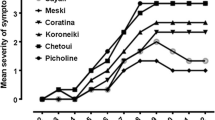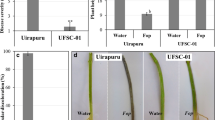Abstract
To determine whether differences in olive susceptibility to Verticillium dahliae are accompanied by differential biochemical and physiological defense responses, we monitored the changes in fungal DNA concentration, membrane conductivity, total polyphenols, orthodihydroxyphenols, lignin and defense-related enzymes in the stems and roots of two olive cultivars differing by their susceptibility to V. dahliae. Fungal DNA was detected in the roots at 4 dai and attains a pick of 3.614 and 2.475 ng/100 ng of total DNA, respectively, in the susceptible and resistant cultivars. V. dahliae DNA in the stems was detected from 15 dai and raised slowly to attain a pick of 0.231 ng/100 ng of total DNA in the susceptible cultivar. Correlation tests between the biochemical and physiological parameters revealed that high membrane conductivity, together with early activation of peroxidase (POX) and polyphenol oxidase (PPO), resulted in a reduced root rot and wilt symptoms in the resistant cultivar Sayali when compared to the susceptible cultivar Chemlali. Monitoring of chitinase and β-1,3-glucanase genes’ expression levels indicates that early and simultaneous upregulation of both genes is correlated with reduced susceptibility in the resistant cultivar Sayali. Correlation tests performed between the different studied parameters, revealed a clear association between, POX activity and lignin content (r = 0.873), polyphenols and lignin contents (r = 0.886), PPO activity and OD phenols content (0.795), chitinase and β-1,3-glucanase activities (0.878) in the resistant cultivar Sayali. By contrast, lower correlation coefficients were obtained for the susceptible cultivar Chemlali. Overall, this study provides new insights into the improvement of olive genetic resources.








Similar content being viewed by others
References
Alkher H, El Hadrami A, Rashid KY et al (2009) Pathogenic variation of Verticillium dahliae after serial passages through potato and sunflower. Can J Plant Pathol 31:427–438
Arias-Calderón R, Rodríguez-Jurado D, Bejarano-Alcázar J et al (2015) Evaluation of Verticillium wilt resistance in selections from olive breeding crosses. Euphytica 206(3):619–629
Atallah ZK, Bae J, Jansky SH, Rouse DI, Stevenson WR (2007) Multiplex real-time quantitative PCR to detect and quantify Verticillium dahliae colonization in potato lines that differ in response to Verticillium wilt. Phytopathology 97:865–872
Baidez AG, Gomez P, Del Rio JA et al (2007) Dysfunctionality of the Xylem in Olea europaea L. plants associated with the infection process by Verticillium dahliae Kleb. Role of phenolic compounds in plant defense mechanism. J Agric Food Chem 55(9):3373–3377
Chaari Rkhis A, Gharbi Y, Cheffi M et al (2016) Exploitation des techniques de cultures in vitro pour la sélection contre V. dahliae chez l’olivier. New Science 27:1394–1401
Cheng C, Gao X, Feng B et al (2013) Plant immune response to pathogens differs with changing temperatures. Nat Commun 4:2530
Daayf F, El Hadrami A, El-Bebany A et al (2012) Phenolic Compounds in plant defense and pathogen counter-defense mechanisms. In Cheynier, V, Sarni-Manchado P, Quideau S (eds) Recent advances in polyphenol research, 3. Wiley-Blackwell, Oxford. doi:10.1002/9781118299753.ch8
Funnell DL, Lawrence CB, Pedersen GF et al (2004) Expression of the tobacco β-1,3-glucanase, PR-2d, following induction of SAR with Peronospora tabacina. Physiol Mol Plant Pathol 65:285–296
Gharbi Y, Alkher H, Triki MA et al (2015a) Comparative expression of genes controlling cell wall-degrading enzymes in Verticillium dahliae isolates from olive, potato and sunflower. Physiol Mol Plant Pathol 91:56–65
Gharbi Y, Triki MA, Trabelsi R et al (2015b) Genetic structure of Verticillium dahliae isolates infecting olive tree in Tunisia using AFLP, pathogenicity and PCR markers. Plant Pathol 64:871–879
Gharbi Y, Barkallah M, Bouazizi E et al (2016) Differential fungal colonization and physiological defense responses of new olive cultivars infected by the necrotrophic fungus Verticillium dahliae. Acta Physiol Plant 38:242
Gómez-Lama Cabanas C, Schiliro E, Valverde-Corredor A et al (2015) Systemic responses in a tolerant olive (Olea europaea L.) cultivar upon root colonization by the vascular pathogen Verticillium dahliae. Front Microbiol 6:928
Hanselle T, Barz W (2001) Purification and characterization of the extracellular PR-2b β-1,3-glucanase accumulating in different Ascochyta rabiei-infected chickpea (Cicer arietinum L.) cultivars. Plant Sci 161(4):773–781
Jiménez-Fernandez D, Trapero-Casas JL, Landa BB et al (2016) Characterization of resistance against the olive-defoliating Verticillium dahliae pathotype in selected clones of wild olive. Plant Pathol 65(8):1279–1291
Khan AJ, Deadman ML, Srikandakumar A et al (2001) Biochemical changes in sorghum leaves infected with leaf spot pathogen, Drechslera sorghicola. Plant Pathol J 17(6):342–346
Konig S, Feussner K, Kaever A et al (2014) Soluble phenylpropanoids are involved in the defense response of Arabidopsis against Verticillium longisporum. New Phytol 202(3):823–837
Kumar A, Pundhir VS, Gupka KC (1991) The role of phenols in potato tuber resistance against soft rot by Erwinia carotovora ssp. carotovora. Potato Res 34:9–16
Lewis CE, Walker JRL, Lancester JE et al (1998) Determination of anthocyanins, flavonoids and phenolic acids in potatoes. I: coloured cultivars of Solunum tuberosum L. J Sci Food Agric 77:45–57
Lopèz-Escudero FJ, del Rio C, Caballero JM et al (2004) Evaluation of olive cultivars for resistance to Verticillium dahliae. Eur J Plant Pathol 110:79–85
Markakis EA, Tjamos SE, Antoniou PP et al (2010) Phenolic responses of resistant and susceptible olive cultivars induced by defoliating and non-defoliating Verticillium dahliae pathotypes. Plant Dis 94:1156–1162
Mercado-Blanco J, Collado-Romero M, Parrilla-Araujo S, Rodríguez-Jurado D, Jiménez-Díaz RM (2003) Quantitative monitoring of colonization of olive genotypes by Verticillium dahliae pathotypes with real-time polymerase chain reaction. Physiol Mol Plant Pathol 63:91–105
Mohanraj D, Padmanaban P, Karunakaran M (2003) Pathogen toxin-induced electrolyte leakage and phytoalexin accumulation as indices of red-rot (Colletotrichum falcatum Went) resistance in sugarcane. Phytopathol Mediterr 42:129–134
Moreira-Vilar FC, De Siqueira-Soares R, Finger-Teixeira A et al (2014) The acetyl bromide method is faster, simpler and presents best recovery of lignin in different herbaceous tissues than klason and thioglycolic acid methods. PLoS One 9(10):e110000. doi:10.1371/journal.pone.0110000
Morello P, Diez CM, Codes M et al (2015) Sanitation of olive plants infected by Verticillium dahliae using heat treatments. Plant Pathol 65(3):412–421
National Olive Office (2015) Positionnement de la Tunisie sur le Marché Mondial d’Huile d’Olive. http://www.onh.com.tn/index.php/fr/positionnement-de-la-tunisie-sur-le-marche-mondial-d-huile-d-olive. Accessed 20 Nov 2015
Ngadze E, Icishahayo D, Coutinho TA et al (2012) Role of polyphenol oxidase, peroxidase, phenylalanine ammonia lyase, chlorogenic acid, and total soluble phenols in resistance of potatoes to soft rot. Plant Dis 96(2):186–192
Palloix A, Ayme V, Moury B (2009) Durability of plant major resistance genes to pathogens depends on the genetic background, experimental evidence and consequences for breeding strategies. New Phytol 183:190–199
Pottosin I, Velarde-Buendía AM, Bose J et al (2014) Cross-talk between reactive oxygen species and polyamines in regulation of ion transport across the plasma membrane: implications for plant adaptive responses. J Exp Bot 65(5):1271–1283
Pusztahelyi T, Holb IJ, Pocsi I (2015) Secondary metabolites in fungus-plant interactions. Front Plant Sci 6:573
Roca LF, Moral J, Trapero C et al (2016) Effect of inoculum density on Verticillium wilt incidence in commercial olive orchards. J Phytopathol 164:61–64
Shi H, Liu Z, Zhu L et al (2012) Overexpression of cotton (Gossypium hirsutum) dirigent1 gene enhances lignification that blocks the spread of Verticillium dahliae. Acta Bioch Bioph Sin 44(7):555–564
Sofo A, Dichio B, Xiloyannis C et al (2004) Effects of different irradiance levels on some antioxidant enzymes and on malondialdehyde content during rewatering in olive tree. Plant Sci 166:293–302
St Clair DA (2010) quantitative disease resistance and quantitative resistance loci in breeding. Annu Rev Phytopathol 48:247–268
Trapero C, Rallo L, López-Escudero FJ et al (2015) Variability and selection of verticillium wilt resistant genotypes in cultivated olive and in the Olea genus. Plant Pathol 64:890–900
Vandana VV, Suseela Bhai R, Shamina A (2014) Biochemical defense responses of black pepper (Piper nigrum L.) lines to Phytophthora capsici. Physiol Mol Plant Pathol 88:18–27
Velazhahan R, Muthukrishnan S (2004) Transgenic tobacco plants constitutively overexpressing a rice thaumatin-like protein (PR-5) show enhanced resistance to Alternaria alternate. Biol Plant 47:347–354
Wan J, Zhang XC, Stacey G (2008) Chitin signaling and plant disease resistance. Plant Signal Behav 3(10):831–833
War AR, Paulraj MG, War MY et al (2012) Herbivore-induced resistance in different groundnut germplasm lines to Asian armyworm, Spodoptera litura (Fab.) (Lepidoptera: Noctuidae). Acta Physiol Plant 34(1):343–352
Xu B, Escamilla-Trevino LL, Sathitsuksanoh N et al (2011a) Silencing of 4-coumarate: coenzyme A ligase in switch grass leads to reduced lignin content and improved fermentable sugar yields for biofuel production. New Phytol 192:611–625
Xu L, Zhu L, Tu L et al (2011b) Lignin metabolism has a central role in the resistance of cotton to the wilt fungus Verticillium dahliae as revealed by RNA-Seq-dependent transcriptional analysis and histochemistry. J Exp Bot 62(15):5607–5621
Acknowledgements
This study was supported in part by a grant from the PESTOLIVE project in Tunisia to M.A. Triki, and Research Laboratory APREGO, and the research unit of toxicology–environmental microbiology and health to R. Gdoura.
Author information
Authors and Affiliations
Corresponding author
Ethics declarations
Conflict of interest
We have read and understood the journal policy on declaration of interests and we have no conflict of interest to declare.
Additional information
Communicated by L Bavaresco.
Rights and permissions
About this article
Cite this article
Gharbi, Y., Barkallah, M., Bouazizi, E. et al. Lignification, phenols accumulation, induction of PR proteins and antioxidant-related enzymes are key factors in the resistance of Olea europaea to Verticillium wilt of olive. Acta Physiol Plant 39, 43 (2017). https://doi.org/10.1007/s11738-016-2343-z
Received:
Revised:
Accepted:
Published:
DOI: https://doi.org/10.1007/s11738-016-2343-z




